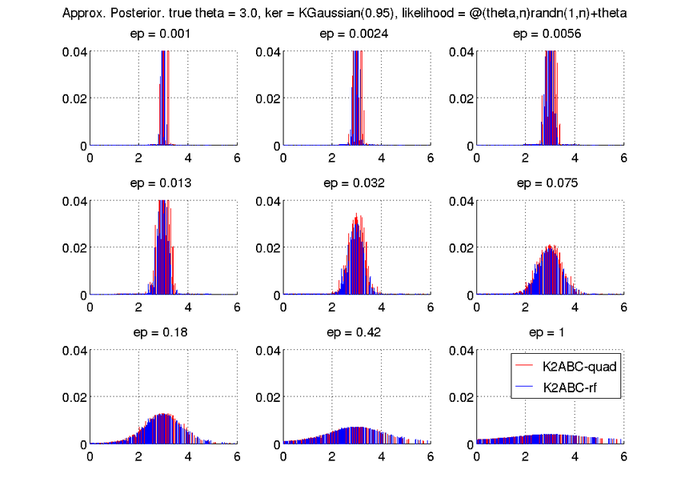AISTATS 2016. K2-ABC: Approximate Bayesian Computation with Kernel Embeddings.
This repository contains Matlab implementation of K2-ABC as described in
K2-ABC: Approximate Bayesian Computation with Kernel EmbeddingsMijung Park, Wittawat Jitkrittum, Dino SejdinovicAISTATS 2016
See the paper here.
code/ folder with cd code.startup to include necessary dependency.demo_k2abc_rf to see a demo. The full code is at
% Set up a likelihood function (theta, n) -> data. Here n is the number of points% to draw for each parameter theta. This function should return d x n matrix% in general.likelihood_func = @(theta, n)randn(1, n) + theta;% True mean is 3.true_theta = 3;% Set the number of observations to 200num_obs = 200;% number of random featuresnfeatures = 50;% Generate the set of observationsobs = likelihood_func(true_theta, num_obs );% options. All options are described in ssf_kernel_abc.op = struct();% A proposal distribution for drawing the latent variables of interest.% func_handle : n -> (d' x n) where n is the number of samples to draw.% Return a d' x n matrix.% Here we use 0-mean Gaussian proposal with variance 8.op.proposal_dist = @(n)randn(1, n)*sqrt(8);op.likelihood_func = likelihood_func;% List of ABC tolerances. Will try all of them one by one.op.epsilon_list = logspace(-3, 0, 9);% Sample size from the posterior.op.num_latent_draws = 500;% number of pseudo data to draw e.g., the data drawn from the likelihood function% for each thetaop.num_pseudo_data = 200;% Set the Gaussian width using the median heuristic.width2 = meddistance(obs)^2;% Gaussian kernel takes width squaredker = KGaussian(width2);% This option setting is not necessary for K2-ABC width quadratic MMD.% Online for random Fourier features.op.feature_map = ker.getRandFeatureMap(nfeatures, 1);% Run K2-ABC with random features% Rrf contains latent samples and their weights for each epsilon.[Rrf, op] = k2abc_rf(obs, op);% Run K2-ABC with full quadratic MMD[R, op] = k2abc(obs, op);% Plot the resultsfigurecols = 3;num_eps = length(op.epsilon_list);for ei = 1:num_epssubplot(ceil(num_eps/cols), cols, ei);ep = op.epsilon_list(ei);% plot empirical distribution of the drawn latenthold on%plot(Rrf.latent_samples(Ilin), Rrf.norm_weights(Ilin, ei), '-b');%plot(R.latent_samples(I), R.norm_weights(I, ei), '-r');stem(R.latent_samples, R.norm_weights(:, ei), 'r', 'Marker', 'none');stem(Rrf.latent_samples, Rrf.norm_weights(:, ei), 'b', 'Marker', 'none');set(gca, 'fontsize', 16);title(sprintf('ep = %.2g ', ep ));xlim([true_theta-3, true_theta+3]);ylim([0, 0.04]);grid onhold offendlegend('K2ABC-quad', 'K2ABC-rf')superTitle=sprintf('Approx. Posterior. true theta = %.1f, ker = %s, likelihood = %s', true_theta, ...ker.shortSummary(), func2str(op.likelihood_func));annotation('textbox', [0 0.9 1 0.1], ...'String', superTitle, ...'EdgeColor', 'none', ...'HorizontalAlignment', 'center', ...'FontSize', 16)
The script will show the following plot.

In both K2-ABC with full quadratic MMD (K2ABC-quad), and K2-ABC with
random features (K2ABC-rf), the posterior samples concentrate around the true mean 3.
We observe that small epsilons tend to yield posterior distributions with smaller variance.